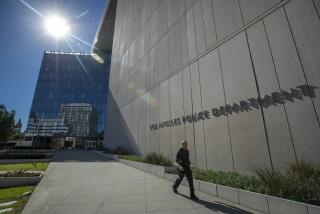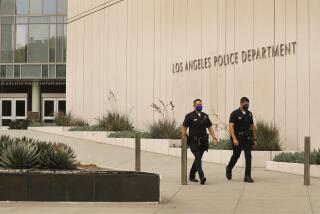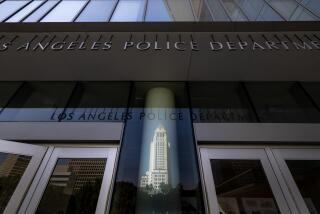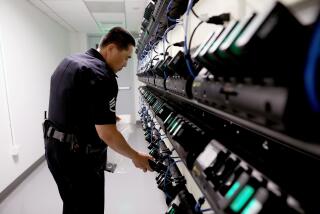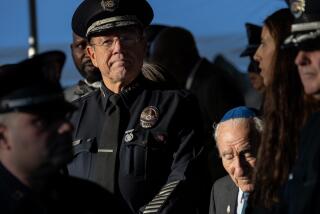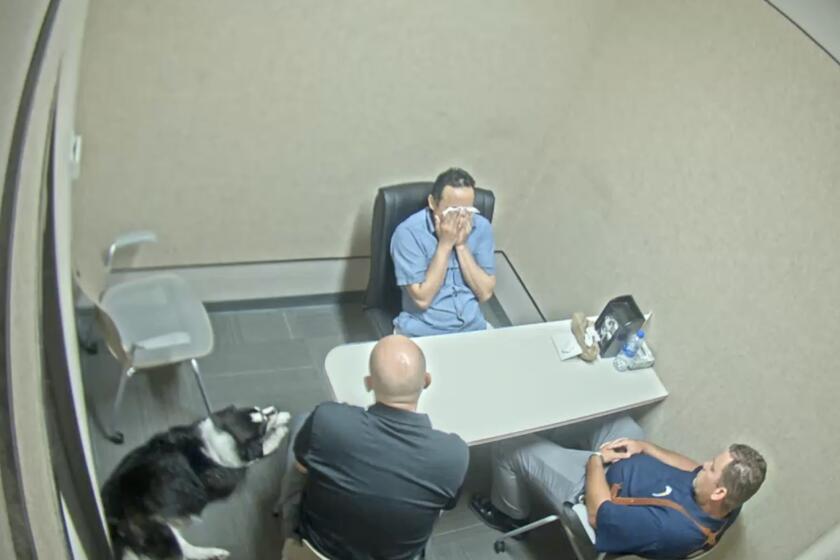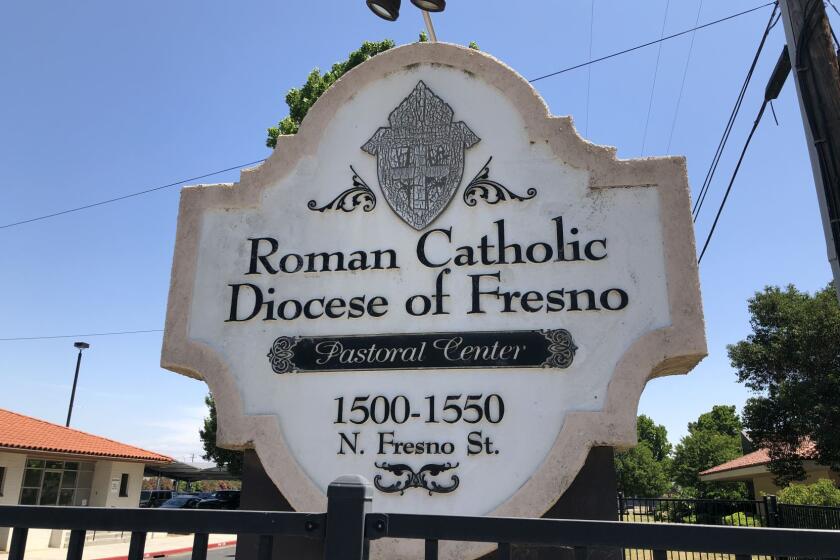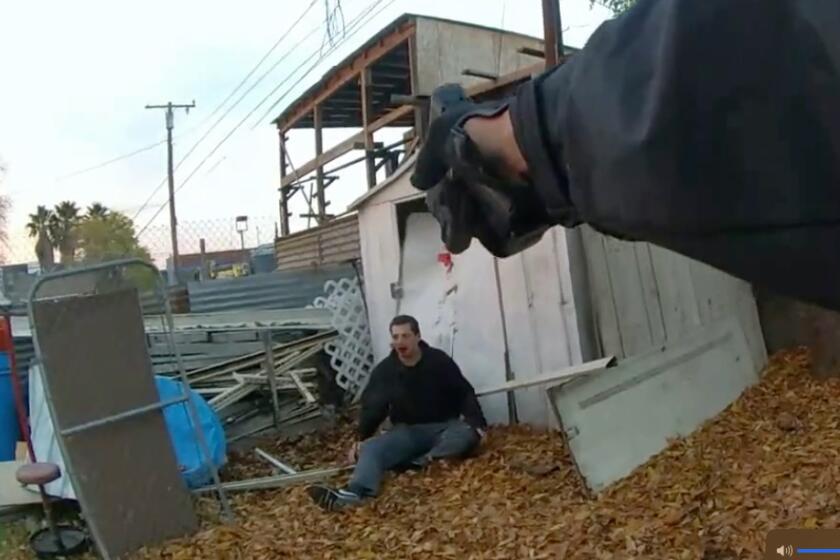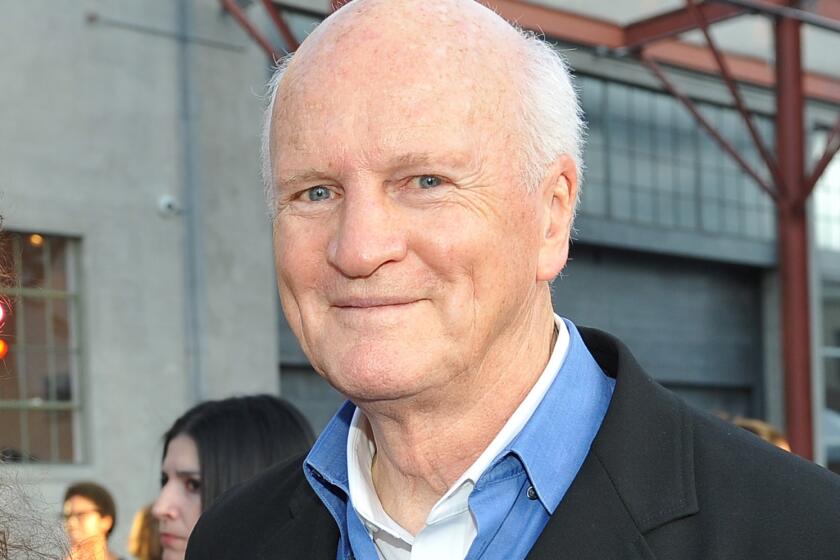Brass knuckles, body cams and bad behavior: LAPD probe links troubled Valley gang units

As Los Angeles police internal investigators dig deeper into one of the bigger scandals in recent department history, they have uncovered links between two troubled anti-gang units in the San Fernando Valley, multiple law enforcement sources told The Times.
When the controversy first spilled into public view in August — with officers accused of illegally searching and stealing from people, and attempting to cover it up by turning off their body cameras — then-Chief Michel Moore said the problems appeared to be confined to the Mission Division.
But three sources, who spoke on the condition of anonymity because they feared retaliation for discussing a pending investigation and sensitive personnel matters, said the probe had broadened to focus on a group of officers who initially worked together in another police division, Foothill, which neighbors Mission to the east.
One of those officers, Alan Carrillo, pleaded not guilty this week to charges of theft and evidence tampering. He previously worked on the Foothill gang squad, whose other officers have in recent years been accused of violent tactics against protesters and at least one out-of-policy shooting of an unarmed man, according to court records and sources familiar with the LAPD’s ongoing investigation.
Carrillo, a six-year department veteran, is the first of several officers expected to be charged, according to one source who agreed to discuss the inner workings of the case on the condition of anonymity. The three sources familiar with the probe said LAPD investigators have spent months exploring the connection between the Mission and Foothill gang units.
Carrillo is accused of stealing personal items — including a knife with brass knuckles on the handle — from people during patrol stops in the Mission Division in April and June 2023. His attorney, Caleb Mason, said in an interview with The Times that his client was being charged for essentially “taking contraband away from a suspect,” who was a minor.
“The prosecution’s theory of the case is that he didn’t fill out the proper paperwork,” Mason said.
He said Carrillo’s case was one of several in which the district attorney’s office’s Justice Systems Integrity Division had overreached in its rush to make good on a campaign promise by Dist. Atty. George Gascón to hold police accountable.
“When an officer encounters a teenager who’s in possession of contraband that he’s absolutely not allowed to have, whether it’s a marijuana vape or brass knuckles, you can’t have that. And you take it away from him, and that’s how good police work has been done for 150 years,” he said. “Frankly, I would hope any officer would take that action.”
Mason said he was handling only Carrillo’s criminal case, and could not comment on the department’s ongoing internal investigation.
Prosecutors have identified as many as 350 criminal cases that are potentially compromised because they relied on the testimony of or evidence gathered by two Mission gang officers. One of them, the sources familiar with the case said, is now believed to be Carrillo.
The incident that prompted the LAPD to scrutinize the Mission Division was a traffic stop that occurred in December 2022 — in Foothill territory, according to two people not authorized to speak publicly about the investigation.
Gang unit members pulled over a woman who later filed a complaint alleging officers had been rude to her, the sources said. When an internal affairs detective looked into the woman’s claims, he spotted inconsistencies between the officers’ written reports and what their body-worn cameras showed, a department source said.
As the investigator continued to dig, a pattern emerged: Mission officers often weren’t turning on their body cameras as department rules require. When they did, it tended to be in cases in which they discovered guns or drugs.
If they came up empty-handed, the officers sometimes wouldn’t turn on their cameras at all. And yet some of their actions were still captured on video, without audio, thanks to an auto-record function that preserves two-minute snippets of footage before the devices are activated.
As the investigation widened, officials reportedly caught Mission officers stealing property, making illegal stops and searches, and failing to record some of these encounters.
Officials believe the officers exploited the department’s relaxed body camera review policy, which requires supervisors to review only a small fraction of the footage recorded every month. The department adopted tighter controls after the scandal broke.
The issues uncovered in the Mission Division coincided with an exodus of officers from Foothill.
It started with the transfer of a gang sergeant named Jorge Gonzalez, who began recruiting some of his former subordinates to join him in Mission, according to three department sources who requested anonymity because they were not authorized to speak about the case.
According to one department source, Gonzalez was initially recommended by area leadership to appear before a disciplinary board for issues related to his lack of supervision of the Mission unit, but interim Police Chief Dominic Choi instead issued him an official reprimand as punishment. Gonzalez did not respond to a request for comment sent to his department email address.
According to a transfer order reviewed by The Times, Carrillo and another gang officer moved from Foothill to Mission in November 2022.
Court records show that in May 2023, Carrillo was involved in a traffic stop along with two other Mission gang officers, Anthony Cardoza and Marvin Perez. They allegedly pulled over a man for having tinted windows and found a loaded gun in his car. The man was charged with gun possession, but his attorney argued in pretrial hearings that the officers lacked probable cause for the search and failed to turn on their body cameras until halfway through the stop. In December, prosecutors dismissed the case.
Cardoza and Perez also came to Mission from Foothill. The two officers had joined the department at the same time and worked similar assignments for several years before reuniting in the Mission gang unit in early 2023, according to a write-up published in the police union’s monthly magazine.
Both officers previously declined to comment.
According to a source familiar with the department’s case, the pair came under scrutiny after an incident in June in which someone complained that the officers threw a cup of iced coffee at a teenager. The source requested not to be named in order to discuss a pending internal investigation.
When the gang unit’s lieutenant went to review a recording of the stop, he noticed the officers had abruptly switched off their body cameras before the reported altercation. He reported this up the chain of command and was instructed to take the officers from the field. He later called the unit together for an impromptu meeting outside the Mission station, reportedly telling his officers he wasn’t afraid of arresting any of them if he found out they were involved in misconduct.
After The Times reported in August 2023 that LAPD internal affairs investigators had taken the rare step of searching the lockers of numerous Mission gang unit officers, Moore announced that the FBI had also opened a case. He also ordered two of the officers involved to a disciplinary hearing by the Board of Rights, signaling that he wanted to fire them.
The unit’s members were dispersed to other assignments or placed on administrative leave. Some, including the unit’s supervisor, Lt. Mark Garza, remain at home, pending the outcome of the department’s investigation.
Garza’s attorney Matthew McNicholas said his client followed procedure by alerting his supervisors as soon as he learned of potential wrongdoing by his officers.
“The only people that fell down on the job were command staff that allowed these people to be moved from Foothill to Mission, without telling anyone of their potential problems,” McNicholas said.
Some of the involved officers were tailed by the LAPD’s secretive Special Operations Division, according to department sources.
During one stakeout, a surveillance team caught two employees having sex at the Mission station. An officer was also caught on a hidden surveillance camera sneaking into the gang unit’s Mission Hills office, even though it was supposed to have been closed.
Some of the alleged problems at Foothill were first raised years ago in a whistleblower lawsuit filed by an LAPD captain, who alleged that he was ignored when he tried to warn his superiors about what he saw as a defiant subculture inside the division’s gang unit.
The captain, Johnny Smith, alleged that the unit’s members retaliated against him when he tried to hold them accountable for misconduct. The suit makes no mention of Carrillo.
In the suit, filed in 2021 in Los Angeles County Superior Court, Smith, then a senior captain at Foothill, alleged that a group of gang officers conspired to file what he said was a frivolous complaint accusing him of making a racist remark. Smith, who is Latino, had accused the officers of participating in a “blue flu” protest — calling out sick en masse — and using excessive force against protesters.
The city has denied the claims made in Smith’s lawsuit, which remains pending. Smith declined to comment.
Several Foothill gang officers came under internal investigation for reportedly using excessive force on protesters after being pelted with bottles during a post-George Floyd demonstration in Sunland-Tujunga in August 2020.
One officer was accused of firing bean-bag rounds into the crowds, striking at least three people who later sued the city, including an Associated Press freelance photographer. In their joint suit, the three argued that such “less-lethal” weapons are generally not meant as a crowd control measure, and yet the officers were using them to disperse protesters, sometimes firing at close range. One of their claims has been settled, with the city agreeing to pay $200,000. The two others are pending.
According to a personnel complaint, body-cam footage showed a Foothill gang officer firing 40-millimeter projectiles at far-left activists at a Westlake spa protest while ignoring counterprotesters who were throwing bottles at police.
Another case involved a sergeant from the Foothill gang unit who was accused in a lawsuit last year of firing at an unarmed man while jumping out of a police SUV that hadn’t yet come to a full stop. The shooting was found to be out of policy by Moore, who concluded that the unarmed man who had just stepped out of a vehicle didn’t pose an “imminent deadly threat.” The city has denied the claims in the lawsuit.
Smith said he warned Moore and other department leaders that, if left unchecked, the officers’ conduct would expose the department to liability. Smith said he was transferred and demoted instead of having his warnings heeded.
Amid the fallout from the scandal, some LAPD oversight experts have wondered whether geography may have something to do with why the alleged corruption at Mission and Foothill went undetected for so long. Both divisions are on the northern edges of the city, far from the eyes of department leaders downtown.
Alex Alonso, a professor at Cal State L.A. who studies street gangs, noted that the Mission Division covers Panorama City and other communities with larger immigrant populations, which may be less willing to come forward and report police abuses.
Alonso said police units with a mandate to aggressively police violent parts of the city are especially prone to bending the rules if left unchecked. He drew a comparison between the Mission and the Rampart corruption scandal of the 1990s, in which officers planted false evidence, stole narcotics and shot people without justification.
“You could say it’s like the Pico-Union of the Valley,” he said.
The department’s Gang Enforcement Details have undergone retraining in the years since the federal consent decree brought on by the Rampart scandal that also urged stricter supervision. As a result, officials said, gang officers are among the most vetted in the department, in part because they are regularly confronted with dangerous situations and engage in aggressive “proactive policing” rather than responding to 911 calls.
Still, some longtime department observers questioned whether police leaders missed previous warning signs at Mission.
The LAPD’s data-driven culture has created “perverse incentives” resulting in past scandals, such as the one that broke out in 2020 when officers from the vaunted Metropolitan Division falsely portrayed people as gang members, according to civil rights attorney Connie Rice.
“If you get attaboys at roll call for how many kids’ names you put in the gang database, guess what, they’re going to just put every kid in the gang database whether there’s probable cause or not,” Rice said. “It gets really cynical after a while because the rules are sometimes stupid, the incentive systems are stupid, their goals are stupid.”
Cops end up frustrated, Rice said, and say to themselves: “You know, if they’re dumb enough to make me do this, then I’m just going to cheat.”
More to Read
More to Read
More to Read
Start your day right
Sign up for Essential California for news, features and recommendations from the L.A. Times and beyond in your inbox six days a week.
You may occasionally receive promotional content from the Los Angeles Times.

